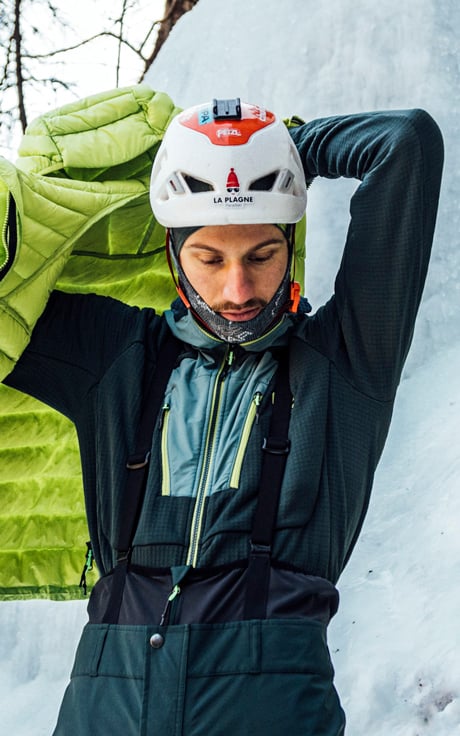
Having the right clothing is essential for alpine climbing. But how do you choose it? Learn the secrets with our guide.
Understanding what alpine climbing means is essential for choosing the right clothing
Alpine-style climbing is distinct from expedition-style mountaineering in that alpinists move lightly and quickly in small teams (or even solo), carrying all their own gear. It’s a demanding discipline at any level of difficulty, and climbers, whatever their objectives, must therefore take the necessary precautions — starting with having the necessary physical and technical preparation to avoid being caught unprepared in the high mountains. But beyond that, you also need clothing designed specifically for alpine climbing, because you can’t practice this discipline in jeans and a T-shirt.
The best alpine climbing garments are ones that protect you from atmospheric agents, resist abrasion against the rock, are comfortable, and offer ample freedom of movement. Choosing the right clothing can really make the difference when you find yourself at altitude in severe weather conditions.
It’s critical to always keep in mind that alpine climbing takes place in the high mountains, where you can be exposed to harsh conditions and where it’s essential to be well equipped in order to ensure an adequate level of safety. This article will share all the most important aspects involved in choosing appropriate clothing for alpine climbing.
Contents
1. Why is a technical base layer so important for alpine climbing?
1.1 What are the differences between technical alpine climbing base layers made of natural materials or synthetic materials?
2. How do you find the right alpine climbing fleece?
3. What is the most suitable down jacket for alpine climbing?
3.1 Goose down or synthetic insulation: Which is better for a down jacket for alpine climbing?
4. What are the important characteristics of alpine climbing pants?
5. What are the functions of an alpine climbing shell?
6. Alpine climbing accessories to always wear or have in your backpack
6.1 What are the best gloves for alpine climbing in the winter?
6.2 The importance of socks in an alpine climber’s outfit
7. The key rules for choosing clothing for alpine climbing
Why is a technical base layer so important for alpine climbing?
Worn directly in contact with the skin, the base layer plays a key role that must be considered carefully when you’re choosing clothing for alpine climbing. Whether it’s made with synthetic or natural materials, its task is to wick away the moisture produced when you sweat, keeping you dry and comfortable.
This is especially critical when you’re in the high mountains, where the temperatures are lower and the weather more extreme. Finding yourself drenched in sweat on a windy pass or in the cold can seriously compromise your physical condition, including creating the risk of hypothermia.
Problems of this type can quickly escalate, resulting in the need for rescue — and it’s important to remember that being rescued in the high mountains or on a wall can never be taken for granted. For this reason, it’s crucial to try to always be as well-equipped as possible, to reduce the risk factors.
With regard to the choice of a base layer for alpine climbing, it’s best to follow a few simple guidelines. Base layers must have a snug fit and allow for full freedom of movement. They must be breathable, and any seams must be flat, so as not to create unpleasant chafing while you’re moving. An alpine climbing base layer must fit like a second skin, to the point that you almost forget you’re wearing it while you’re climbing.
What are the differences between technical alpine climbing base layers made of natural materials or synthetic materials?
A vast assortment of technical base layers for alpine climbing and other outdoor sports are available on the market. One of the best solutions is certainly garments made of merino wool. They insulate you from the cold, allowing you to conserve body heat even in damp conditions, and they have natural antibacterial properties and ensure odor control.
They’re also soft and comfortable against the skin, without forgetting the most important feature: their high level of breathability, which keeps the body dry and comfortable.There’s also the option of wearing technical alpine climbing base layers in synthetic materials.
This solution allows you to have lighter-weight and even more breathable garments, which is useful when you’re engaging in high-intensity activity for which wool is too heavy. In addition, synthetic materials are quick-drying, which reduces the risk that you’ll find yourself with damp or wet skin.
How do you find the right alpine climbing fleece?
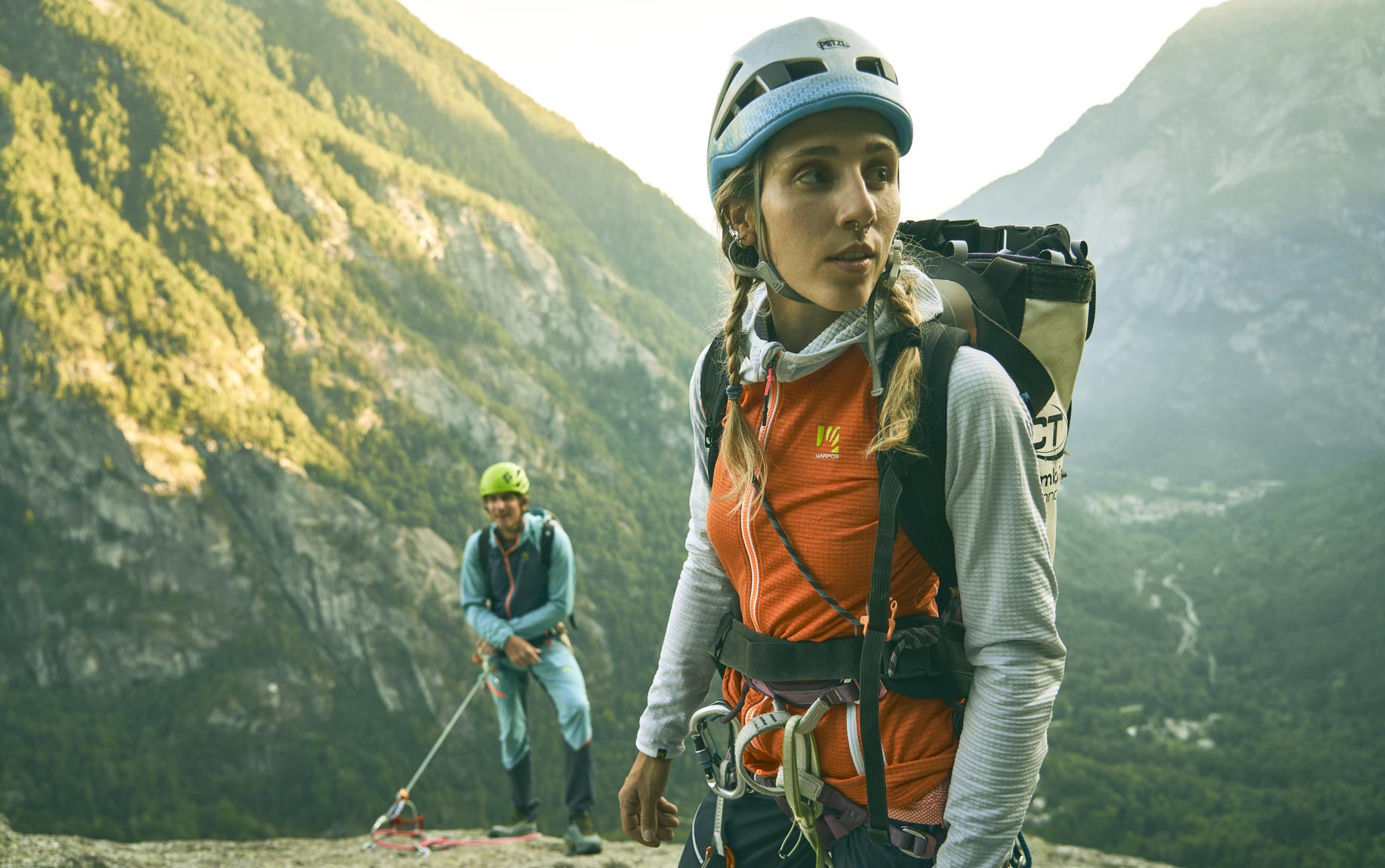
When choosing alpine climbing clothing, it’s good to take some time to find the right fleece. There’s a wide selection on the market today, offering different levels of warmth, weight, and breathability. Some are suitable for warm summer days, while others are better suited to the high mountains and cold conditions. In short, the choice can’t be left to chance.
In general, when choosing an alpine climbing fleece, you should keep in mind some simple rules: the garment must be lightweight, compact, protective, and breathable. Its task is to provide initial protection from the cold, so it needs to offer thermal insulation.
You can choose a fleece with or without a zipper. Full-zip options are certainly more manageable, because they allow you to regulate breathability by opening and closing the zipper as needed. Some fleeces feature more tightly woven fabric to provide basic protection from wind and weather. You can also choose whether you want a hood or not.
It’s important to carefully evaluate the materials as well. For the same weight, for example, you could have an alpine climbing fleece that’s more or less warm, depending on the material it’s made with.
An excellent solution for those looking for an even more technical and versatile garment is an alpine climbing fleece with hybrid construction. A fleece with hybrid construction is made with multiple materials that are able to deliver different functionality to different parts of the body. The front, back, and sleeves, for example, can create an insulating and protective layer. In areas more subject to wear, such as the bottom of the garment and under the armpits, more abrasion-resistant fabrics can be used.
The options are countless and diverse, giving everyone the possibility to find the solution to all their needs in a single garment.
A further element that differentiates an alpine climbing fleece from a less technical product is the placement of the pockets. In climbing-specific fleeces, the pockets are not positioned solely based on aesthetic criteria; there’s a careful study behind their placement to ensure that a climber’s movements are not hindered when they’re wearing a harness.
What is the most suitable down jacket for alpine climbing?
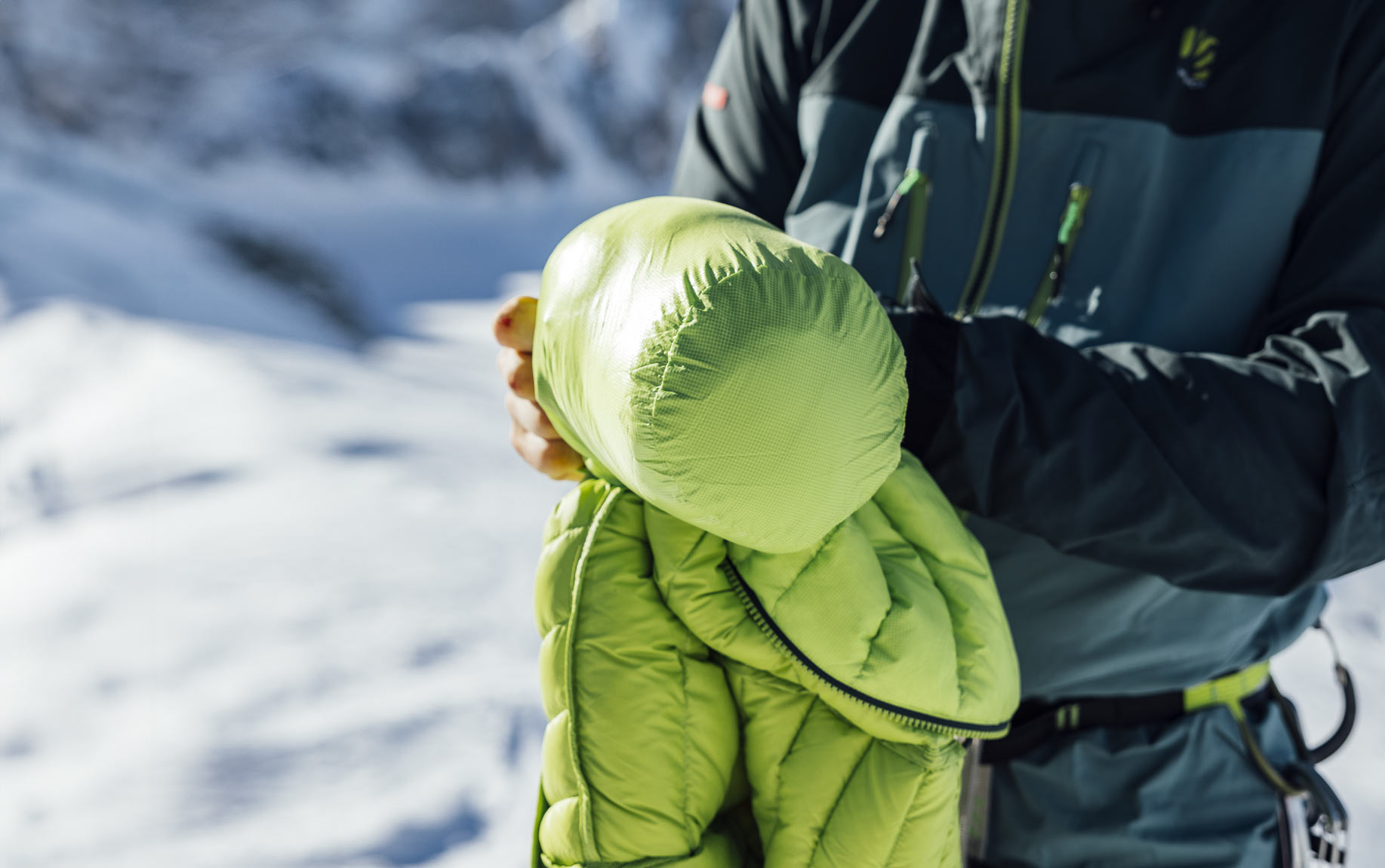
A down jacket is essential for mountain climbing, especially at high elevations. No alpine climber would ever forget their warm and protective down jacket, to be worn in the early hours of the day, during breaks, or when the weather conditions change, bringing in cold air.
A down jacket or thermal jacket is essential to keep you warm and comfortable so you can continue to enjoy the climb even when the temperature drops. Today the market offers a wide choice, with many types of jackets that are perfect for alpine climbing.
There are three basic rules to keep in mind when choosing a down jacket for alpine climbing. A good down jacket must be
- lightweight,
- easily compressible, and
- resistant to abrasion and tears.
These characteristics allow it to take up little space in your backpack and to reduce the possibility of damage in case of abrasion against the rock.
Today, the best down jackets for alpine climbing are made with materials specifically designed to be durable and longer-lasting. A down jacket with the outer fabric made of Cordura® ripstop, for example, will certainly last longer than a less technical garment.
In addition to the choice of materials, a down jacket for alpine climbing also differs in terms of the research that goes into its components. For example, the hood is shaped in such a way that it’s easy to use even when you’re wearing a helmet, and it often features a rigid visor and the possibility of adjustment to ensure maximum front and side visibility.
The positioning of the pockets, as well as the orientation of the zippers, is designed to accommodate those who also need to use a harness while wearing the garment. For this reason, the pockets are often located slightly higher than normal and with the zipper placed diagonally, with the upper end more toward the inside.
Goose down or synthetic insulation: Which is better for a down jacket for alpine climbing?
The importance of the insulation should also not be underestimated. Although down jackets for alpine climbing may all seem the same, this is not the case at all, and they have different characteristics depending on the insulation material, which can be synthetic or natural. It’s good to understand these differences before making a purchase.
Natural down is known for its excellent thermal properties. In fact, it has the highest warmth-to-weight ratio and greatest compressibility on the market, which makes it the best solution for keeping you warmer with the same weight. Its weakness is moisture; once it gets wet, it loses a significant amount of its insulating power.
The solution to this problem is the new down jackets for alpine climbing made with goose down insulation that’s been treated with a DWR (durable water repellent). The DWR treatment causes the surface of the down to repel water, so it forms droplets that slide away instead of being absorbed. The garment thus maintains its insulation value even in very damp conditions.
It’s helpful to understand the different levels of natural insulation that are available on the market, in order to choose the down jacket with the right level of thermal insulation for your alpine climbing needs. A higher fill power value corresponds to a higher level of warmth, as the feathers take up more volume and can trap more air.
A synthetic down jacket is a perfect choice for climbing in difficult weather conditions, with rain and snow, as it maintains its thermal insulation characteristics even in wet conditions. Synthetic insulation is also more robust and durable. In the event of a tear in the fabric, the compactness of the insulation means that material losses are much less likely.
What are the important characteristics of alpine climbing pants?
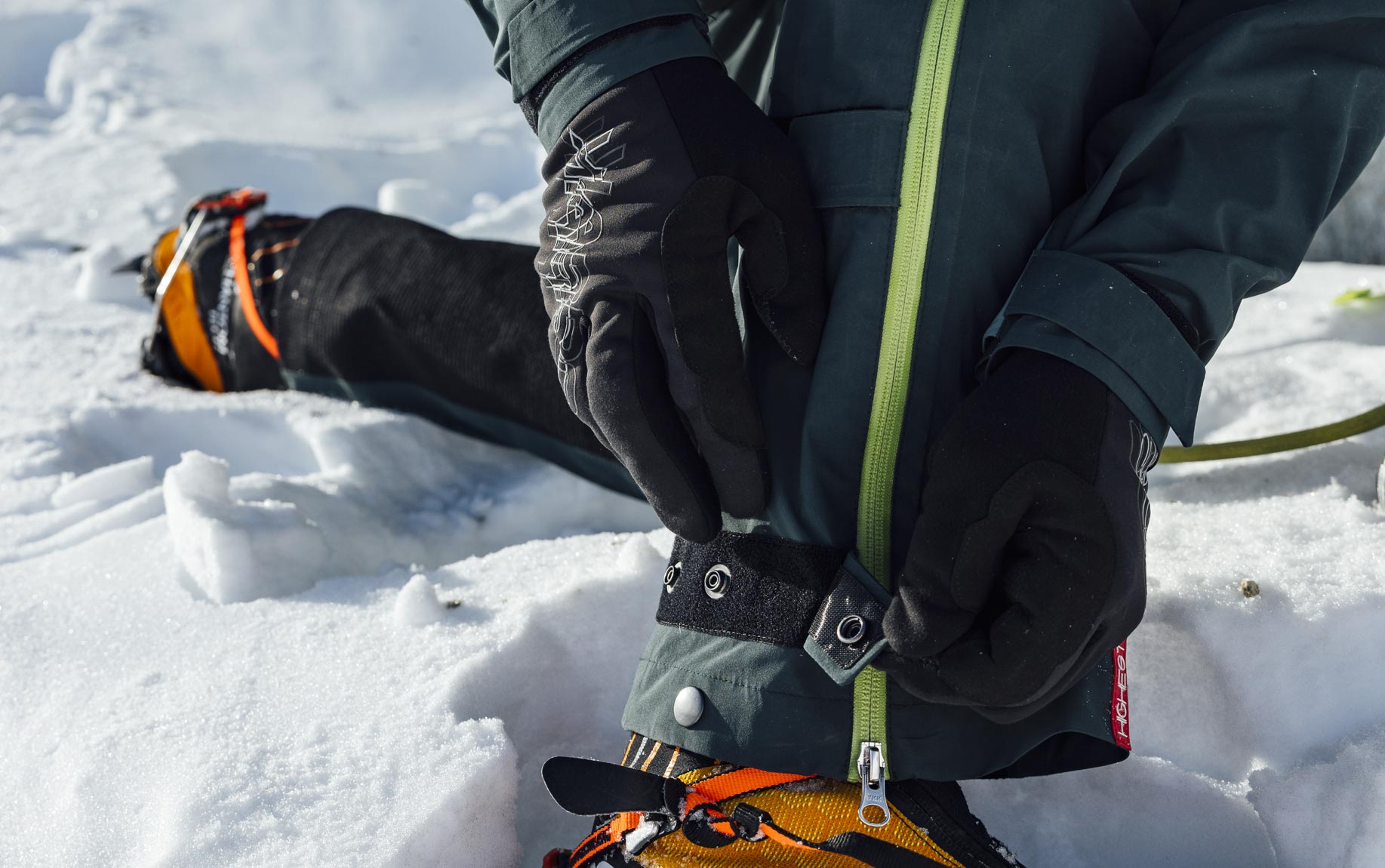
Pants often receive too little attention in the choice of clothing for alpine climbing, but they’re a key garment in harsh environments and challenging conditions. They must be technical and practical, helpful and supportive during the climb. They must offer freedom of movement and not hinder your steps.
There are many different types on the market, each with its own characteristics and each designed for specific activities or conditions. In general, we can say that pants for alpine climbing must be abrasion-resistant, lightweight, and stretchy. If you climb at high elevations or in the winter, they must also be warm and insulating, while providing the right breathability to keep you dry.
Some styles of alpine climbing pants may also feature panels of tightly woven fabric to provide basic wind protection. They usually have pockets positioned where they can be easily accessed when used with a harness. And the most exposed and wear-prone areas can be reinforced with abrasion-resistant fabrics such as Cordura®.
To improve comfort while you’re walking and climbing, alpine climbing pants feature shaped knees that allow maximum freedom of movement. Finally, for outings on snowy terrain, don’t overlook the importance of gaiters at the bottom of the legs to keep snow out and allow your feet to stay warm and dry.
What are the functions of an alpine climbing shell?
Lightweight, durable, and protective, a shell is an essential item when choosing clothing for alpine climbing. It must take up minimal space and weigh little, but above all it must be protective, breathable, and durable.
On a climb, you’ll use the shell at various times during the day: to block wind gusts, to keep you dry in a sudden downpour, or to protect you from the snow. For this reason, the shell must be efficient and functional so that you can put it on and take it off quickly.
The best alpine climbing shells offer a high level of waterproofness — a water column of at least 20,000 mm — and can keep you completely dry even during prolonged use. At the same time, they offer a high degree of breathability, thanks also to practical ventilation zips that help evacuate moisture generated during activity. Put simply, the best alpine climbing shell is the one that keeps you dry and comfortable.
As with the other alpine climbing garments, every element of the shell is designed to best perform its specific task, allowing you to move with maximum agility.
So, for example, the hood features a contoured shape, drawcord adjustment, and a rigid visor, and is designed for use with a helmet. And all the pockets have been designed with a specific shape and position so as not to hinder the use of a harness.

Alpine climbing accessories to always wear or have in your backpack
Whether it’s summer or winter, when choosing clothing for alpine climbing, you must always include some essential accessories, such as gloves and a cap to keep you warm in the early hours of the day and in the evening, but also during outdoor activities at high elevations. A good pair of waterproof and breathable alpine climbing gloves will make all the difference up on the glacier.
When you’re climbing, the conditions you encounter may be such that a simple cap is not enough to provide an adequate level of warmth. So it’s best to equip yourself with a collection of accessories that can respond to these important needs, since the most peripheral areas of the body are also those most sensitive to cold.
Having a neck warmer with you, maybe a thick one, is a smart choice to protect yourself from the wind and limit heat loss. In some situations, it might be even better to have a balaclava, which provides the best protection for the face and head.
What are the best gloves for alpine climbing in the winter?
For alpine climbing in the winter or at high elevations, gloves must above all be warm. Mittens represent the ideal solution for these conditions. Although you sacrifice some dexterity, mittens keep all your fingers together in the same space, thus generating more warmth than traditional five-finger gloves.
The importance of socks in an alpine climber’s outfit
Boots are a key piece of alpine climbing gear; they need to be chosen carefully and deserve a separate in-depth discussion. But the comfort of your feet also depends on your choice of socks — an accessory that is small and hidden and, perhaps for this reason, too often ignored.
It’s better to spend the necessary time choosing them, since they will essentially be your second skin while you’re climbing. A pair of technical socks, designed for use with boots, can really make the difference; they have reinforcements in the right places and can help prevent annoying chafing with consequent irritation or, worse, blisters.
The key rules for choosing clothing for alpine climbing
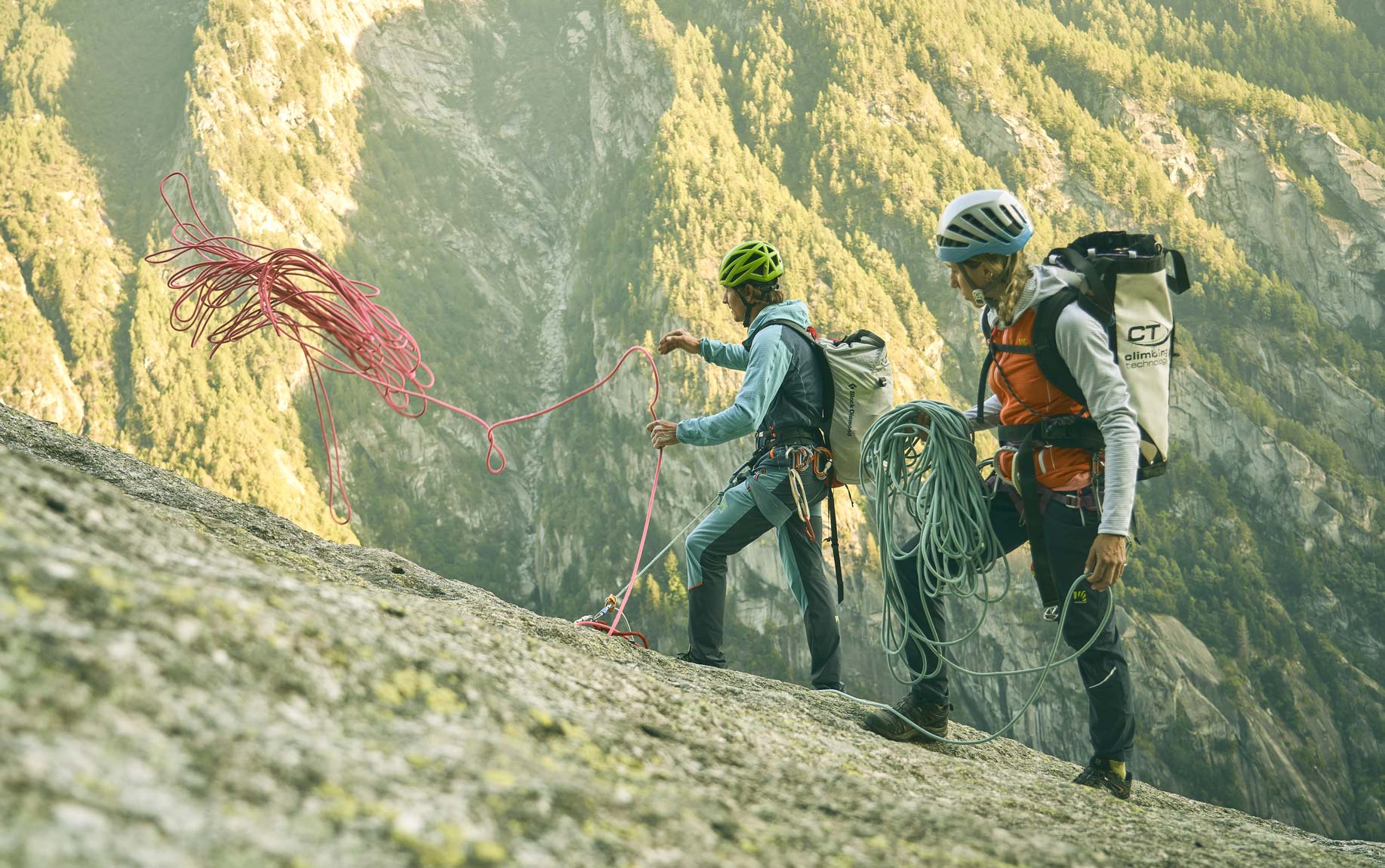
We’ve seen how to choose the right clothing for alpine climbing, which in general must be protective, breathable, and comfortable, allowing for ample freedom of movement — beginning with the choice of base layer, which should be close-fitting against the skin and highly breathable to wick away moisture and keep you dry.
In alpine climbing, it’s essential to protect yourself from the elements, which is why you need to choose a warm and breathable fleece, as well as a down jacket with synthetic or natural insulation, depending on your needs, but made in any case with an abrasion-resistant outer fabric.
The same goes for alpine climbing pants, which in addition to being durable must offer comfort and freedom of movement. The essential alpine climbing shell must be both protective and practical, designed for prolonged use and offering good breathability even during high-intensity activity.
And don’t forget accessories, such as gloves and a cap to keep you warm and technical socks to prevent unpleasant irritation.
Now you can prepare better and head out to discover the exhilaration of the wild mountains, a feeling that you just might find addictive. Enjoy the adventure!